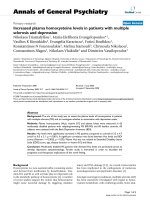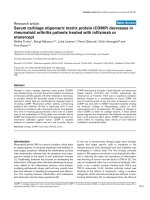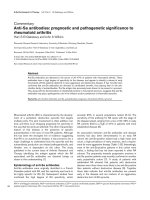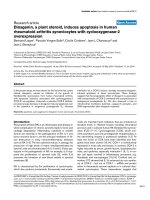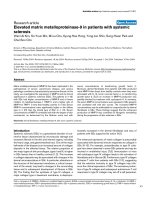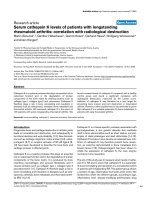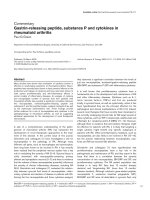Báo cáo y học: "Serum cathepsin K levels of patients with longstanding rheumatoid arthritis: correlation with radiological destruction" pptx
Bạn đang xem bản rút gọn của tài liệu. Xem và tải ngay bản đầy đủ của tài liệu tại đây (132.88 KB, 6 trang )
Open Access
Available online />R65
Vol 7 No 1
Research article
Serum cathepsin K levels of patients with longstanding
rheumatoid arthritis: correlation with radiological destruction
Martin Skoumal
1,2
, Günther Haberhauer
1
, Gernot Kolarz
1
, Gerhard Hawa
3
, Wolfgang Woloszczuk
4
and Anton Klingler
5
1
Institut für Rheumatologie der Kurstadt Baden in Kooperation mit der Donauuniversität Krems, Austria
2
Rheumasonderkrankenanstalt der SVA der gewerblichen Wirtschaft, Baden, Austria
3
Biomedica Medizinprodukte GmbH & CO KG, Vienna, Austria
4
L Boltzmann Institut für experimentelle Endokrinologie, Vienna, Austria
5
Theoretical Surgery Unit, Department of General and Transplant Surgery, University Hospital, Innsbruck, Austria
Corresponding author: Martin Skoumal,
Received: 16 Aug 2004 Revisions requested: 22 Sep 2004 Revisions received: 3 Oct 2004 Accepted: 11 Oct 2004 Published: 10 Nov 2004
Arthritis Res Ther 2005, 7:R65-R70 (DOI 10.1186/ar1461)
http://arthrit is-research.co m/content/7 /1/R65
© 2004 Skoumal et al., licensee BioMed Central Ltd.
This is an Open Access article distributed under the terms of the Creative Commons Attribution License ( />2.0), which permits unrestricted use, distribution and reproduction in any medium, provided the original work is cited.
Abstract
Cathepsin K is a cysteine protease that plays an essential role in
osteoclast function and in the degradation of protein
components of the bone matrix by cleaving proteins such as
collagen type I, collagen type II and osteonectin. Cathepsin K
therefore plays a role in bone remodelling and resorption in
diseases such as osteoporosis, osteolytic bone metastasis and
rheumatoid arthritis. We examined cathepsin K in the serum of
100 patients with active longstanding rheumatoid arthritis. We
found increased levels of cathepsin K compared with a healthy
control group and found a significant correlation with
radiological destruction, measured by the Larsen score.
Inhibition of cathepsin K may therefore be a new target for
preventing bone erosion and joint destruction in rheumatoid
arthritis. However, further studies have to be performed to prove
that cathepsin K is a valuable parameter for bone metabolism in
patients with early rheumatoid arthritis.
Keywords: bone remodelling, cathepsin K, osteoclast activation, rheumatoid arthritis
Introduction
Progressive bone and cartilage destruction in arthritic joints
leads to irreversible joint destruction, and subsequently to
functional declines and work disability [1,2]. New biomark-
ers such as cartilage oligomeric matrix protein [3,4], osteo-
protegerin [5-7] or receptor activator of NF-κB ligand [8-
10] have been developed to describe the local bone and
cartilage process in affected joints.
Cathepsin K is a cysteine protease that plays an essential
role in osteoclast function and in the degradation of protein
components of the bone matrix. It is produced by bone
resorbing macrophages and synovial fibroblasts, and it
cleaves proteins such as collagen type I, collagen type II
and osteonectin [11]. Cathepsin K therefore plays a role in
bone remodelling and resorption in diseases such as oste-
oporosis, osteolytic bone metastasis and rheumatoid arthri-
tis (RA) [12,13].
Cathepsin K is a tissue-specific protease associated with
pycnodysostosis, a rare genetic disorder that manifests
itself in bone abnormalities such as short stature, acroost-
eolysis of distal phalanges and skull deformities [14,15].
Cathepsin K knockout mice develop an osteopetrosis. Inhi-
bition of cathepsin K may therefore prevent bone resorp-
tion, as could be demonstrated in bone metastasis from
breast cancer [16]. Osteoprotegerin has been shown to
inhibit the expression of cathepsin K, the main enzyme
involved in bone resorption.
The aim of this study was to measure serum levels of cathe-
psin K in RA and to prove that cathepsin K is a parameter
of bone remodelling and resorption in a nonselected cohort
of patients with longstanding RA. This patient group shows
a variation of age, inflammatory level and Larsen score. We
divided this cohort into different groups, according to age,
inflammatory level, disease-modifying antirheumatic drug
CRP = C-reactive protein; DMARD = disease-modifying antirheumatic drug; ELISA = enzyme-linked immunosorbent assay; IL = interleukin; NF =
nuclear factor; RA = rheumatoid arthritis.
Arthritis Research & Therapy Vol 7 No 1 Skoumal et al.
R66
(DMARD) therapy, radiological progression and disease
activity, to verify cathepsin K as an age-independent and
laboratory inflammatory parameter-independent protease.
Materials and methods
Serum levels of cathepsin K were measured in the sera of
100 patients suffering from RA according to the criteria of
the American Rheumatism Association [17]. Clinical and
laboratory data are presented in Tables 1 and 2. The con-
trol group consisted of nonselected healthy blood donors
from a central blood bank (n = 50; 21 female, 29 male)
aged 18–65 years.
Most of the patients received DMARDs. The most fre-
quently used DMARD was methotrexate, followed by leflu-
nomide, sulfasalzopyrine and gold. Furthermore,
azathioprine and chloroquine but no biological therapy
were prescribed (Table 3).
Each examination consisted of a full interview, the assess-
ment of functional disability and a standardised physical
examination, which included a joint examination for tender-
ness (Ritchie score), pain on motion, soft tissue swelling,
44-swollen joint count and swollen proximal interphalan-
geal score [18,19].
The disease activity of RA was measured by the disease
activity score (≤ 2.4, low activity; > 2.5 and ≤ 3.7, mean
activity; > 3.7, high activity). The radiological progression in
RA was calculated by the Larsen score [20].
The blood examination at each visit consisted of the deter-
mination of cathepsin K, the erythrocyte sedimentation rate,
the haemoglobin level, the thrombocyte count, the serum
rheumatoid factor (RapiTex
®
RF; Dade Behring, Lieder-
bach, Germany), antinuclear antibodies (indirect immunflu-
orescent technique, ANA Fluor Kit 240
®
; Diasorin,
Stillwater, MN, USA) and C-reactive protein (CRP) (Rheu-
majet CRP
®
; Biokit, Barcelona, Spain).
Table 1
Clinical parameters of 100 rheumatoid arthritis (RA) patients
Disease duration
(years)
Age at manifestation
(years)
Age (years) Morning stiffness
(min)
Ritchie score Larsen score 44 swollen joint
count
Disease activity
score
Mean 11.7 52.0 62.9 31.9 11.3 54.8 7.4 3.3
Minimum 0.5 18.0 20.0 0.0 0.0 0.0 0.0 0.4
Maximum 56.0 75.0 83.0 130.0 42.0 164.0 28.0 6.0
Standard
deviation
11.6 12.4 11.0 37.8 10.3 49.5 6.8 1.4
Median 8.0 53.0 63.0 15.0 10.0 38.0 6.0 3.6
Table 2
Laboratory parameters of 100 rheumatoid arthritis (RA) patients
Rheumatoid factor (U/l) Erythrocyte sedimentation rate
(mm/hour)
C-reactive protein (mg/l) Leucocytes (g/l) Cathepsin K (pmol/l)
Mean 298.8 30.3 25.0 7.2 304.7
Standard deviation 1142.3 20.9 23.4 2.2 681.0
Median 27.0 30.0 20.0 7.0 54.8
Table 3
Distribution of disease-modifying antirheumatic drug in 100 rheumatoid arthritis patients
Disease-modifying antirheumatic drug
None Methotrexate Leflunomide Sulfasalazopyrine Gold Chloroquine Others
Number 22 42 10 10 6 4 6
Available online />R67
The variables of age, sex, duration of disease, visual ana-
logue scale of general health and morning stiffness, treat-
ment with DMARDs and reason for their discontinuation,
and the Steinbrocker stage [21] were also recorded.
Serum was obtained in the morning from the routinely taken
blood samples and was centrifuged immediately. The sam-
ples were kept at -80°C prior to determination of cathepsin
K. The serum used for the measurement of cathepsin K was
the remainder from routinely drawn blood examinations on
the day of hospitalisation; no examination was performed
only for quantification of cathepsin K. Clinical data were
used from a database developed for the long-term observa-
tion of patients with RA in our clinic.
An enzyme immunoassay for cathepsin K developed by
Biomedica Austria (Vienna, Austria) was used. The Cathe-
psin K test kit is an enzyme immunoassay designed to
determine cathepsin K directly in biological fluids (serum,
plasma, cell culture supernatants). The ELISA used in this
study is based on antibodies specific for amino acids 1–20
and amino acids 196–210 of the mature enzyme. The anti-
bodies were produced by immunisation of sheep with pep-
tides of that amino acid sequence coupled to Keyhole
Limpet Hämocyanine (primary immunisation, 0.5 mg; boost,
0.25 mg). Antisera were purified using the biotinylated pep-
tides coupled to streptavidine sepharose (Amersham-Phar-
macia Biotech Ltd, Little Chalfont, UK). A synthetic
cathepsin K (Pichem GmbH, Graz, Austria) was used as
the calibrator. Signal generation was accomplished by
labelling with horseradish peroxidase.
Briefly, the assay procedure consisted of incubating 50 µl
sample with 200 µl horseradish peroxidase-labelled detec-
tion antibody on capture antibody precoated plates over-
night at room temperature. After a washing step to remove
unbound detection antibody, tetramethyl benzidine was
added as the substrate. The reaction was stopped after 30
min by adding 50 µl of 0.9% H
2
SO
4
. The yellow colour that
is directly proportional to the amount of cathepsin K
present in the sample was measured on a standard micro-
plate reader at 450 nm with 620 nm as the reference. The
detection limit of the assay was calculated as 1.1 pmol/l (0
standard + 5 × standard deviation).
No cross-reactivity to cathepsin E, cathepsin D, cathepsin
B and cathepsin L or rheumatoid factors was detected.
Statistical methods included Spearman correlation analy-
sis, the Wilcoxon two-sample test the Kruskal–Wallis test
and analysis of variance, if appropriate. P < 5% was con-
sidered statistically significant.
Results
The cathepsin K serum levels of the patients with RA
(median first–third quartile range, 54.8 pmol/l) compared
with the healthy control group (median first–third quartile
range, 12.7 pmol/l) were significantly elevated (P =
0.0003) (Table 4).
The Larsen score ranged from 0 to 164 (median score, 39).
The Spearman rank correlation showed a statistically signif-
icant correlation between cathepsin K and the Larsen
score (P = 0.004). The highest levels of cathepsin K were
observed in patients with the highest Larsen scores. We
divided the cohort into three Larsen groups with equal num-
bers of patients (Larsen score < 18 points, Larsen score
between 19 and 74 points, and Larsen score ≥ 75 points).
Cathepsin K levels showed an increase with the augmenta-
tion of radiological destruction (P = 0.035) (Table 5).
Cathepsin K seems to be independent or only weakly cor-
related with laboratory inflammation parameters. It was not
associated with CRP (P = 0.27), but weak correlations
were found with the erythrocyte sedimentation rate (P =
0.03) and the disease activity score of the whole cohort (P
= 0.04). However, the division of the disease activity score
into three groups with low activity, medium activity and high
activity did not show any difference. We could not find any
correlation with sex and age (whole group/division into two
patient groups ≤ 65 years and ≥ 66 years, P = 0.32),
whereby the two groups were comparable in disease activ-
ity (3.53 versus 3.12), laboratory parameters (CRP, 25.4
mg/l versus 25.9 mg/l), clinical score (Ritchie score, 14
versus 9) and radiological score (Larsen score, 47 versus
62).
The most frequently used DMARD was methotrexate (n =
42), followed by leflunomide (n = 10) and sulfasalzine (n =
10). Twenty-two patients had no DMARD at the time of
examination (Table 3). The lowest cathepsin K levels were
evident in the leflunomide group, but no significant differ-
ence between these groups could be demonstrated.
Discussion
Bone resorption and formation is a well-balanced system
and is mediated by osteoclasts. Cathepsin K is essential for
bone resorption, which depends on the production of
cathepsin K by osteoclasts and its secretion into the extra-
cellular department. This leads to a degradation of the
organic matrix between the osteoclasts and the bone sur-
face [22]. In vivo the activation of cathepsin K occurs intra-
cellularly, before secretion into the resorbing lacunae and
the onset of bone resorption, whereby local factors may
regulate the processing of procathepsin K to mature cathe-
psin K [23]. In accordance with this, synovial fibroblasts are
also involved in joint destruction and in the pathogenesis of
RA. Hou and colleagues found that cathepsin K has a
potent aggrecan-degrading activity, whereby the aggrecan
cleavage products increase the collagenolytic effects of
this protease on collagen type I and type II. They were able
Arthritis Research & Therapy Vol 7 No 1 Skoumal et al.
R68
to show that cathepsin K is also a critical protease in carti-
lage degradation by synovial fibroblasts [24]. Increased
expression of cathepsin K around lymphocytic infiltrates in
synovial tissue seems to facilitate the movement of mono-
nuclear cells through the perivascular matrix [25]
Proinflammatory cytokines such as IL-1β and tumour necro-
sis factor alpha influence the expression of cathepsin K. Its
overexpression in the rheumatoid synovium, induced by IL-
1β and tumour necrosis factor alpha due to the increase of
cathepsin K-expressing cells, proves this protease to be a
valuable tool for bone research, and cathepsin K also may
become a new and highly specific biomarker for RA [26].
Votta and colleagues demonstrated high levels of cathep-
sin K expression in osteoclasts at sites of extensive bone
loss. According to this, they developed a peptide aldehyde
inhibitor of cathepsin K that inhibits osteoclast-mediated
bone resorption in foetal rat long bone organ cultures and
even in a human osteoclast-mediated assay in vitro. This
inhibitor leads to a significantly reduced bone loss [27].
Furthermore, structure activity studies on a series of revers-
ible ketoamide-based inhibitors of cathepsin K have led to
the identification of potent and selective inhibitors [28].
Wittrant and colleagues demonstrated osteoprotegerin to
be an inhibitor of cathepsin K. Osteoprotegerin is an oste-
oblast-secreted decoy receptor that inhibits osteoclast dif-
ferentiation and activation. Human osteoprotegerin inhibits
cathepsin K and tartrate-resistant acid phosphatase, both
osteoclast markers, but stimulates the expression of tissue
inhibitor of metalloproteinases-1 [29]. These results are a
further step in the development of new therapies for the
prevention of bone destruction.
In the synovium of RA, the cathepsin K protein was local-
ised in synovial fibroblasts, stromal multinucleated giant
cells and CD68
+
macrophage-like synoviocytes. Highly
Table 4
Correlations of cathepsin K with clinical, laboratory and radiological parameters
Mean Standard deviation n Coeffficient Probability > |r|
Variable 1
Cathepsin K 304.66 677.607
Variable 2
Age (years) 62.89 11.1581 100 0.0543 0.5915
Rheumatoid factor (U/l) 298.818 1136.49 100 0.4761 < 0.0001
Morning stiffness (min) 32 38.7233 100 0.1320 0.1905
Erythrocyte sedimentation rate (mm/hour) 30.27 20.8404 100 0.2200 0.0279
C-reactive protein (mg/l) 24.96 23.5032 100 0.1121 0.2670
Ritchie score 11.31 10.3394 100 0.1353 0.1797
Proximal interphalangeal score 1.51 2.69865 100 0.2560 0.0101
Disease activity score 3.33283 1.43345 100 0.2093 0.0376
Larsen score 54.77 49.3335 100 0.2856 0.0040
Table 5
Increase of cathepsin K levels with the augmentation of the Larsen score
Larsen group Larsen score Cathepsin K Kruskal–Wallis
test
n Minimum Median Maximum Minimum Median Maximum
< 18 32 0.0 7.5 17.0 0.0 26.5 3352.0
≥ 19 and < 74 34 18.0 38.0 67.0 0.0 70.9 1721.6
≥ 75 34 75.0 105.5 164.0 0.0 88.8 3453.2
Total 100 0.0 39.0 164.0 0.0 54.8 3453.2 P = 0.035
Available online />R69
interesting is the expression of cathepsin K by fibroblasts
and giant cells at sites of cartilage erosions. This was two
to five times higher compared with osteoarthritic synovium.
In normal synovium, cathepsin K expression was not
increased and was restricted to fibroblast like cells [26,30-
32]. The overexpression of cathepsin K in RA synovia
proves that this protease is responsible for the degradation
of articular tissue in rheumatoid joints and in normal syno-
vial tissue.
To our knowledge, no study has previously investigated the
serum levels of cathepsin K in RA. Our results demonstrate
that cathepsin K is elevated in the serum of patients with
RA compared with that of a healthy control group (Table 4).
The upregulation of cathepsin K and the correlation with
the Larsen score as a parameter for radiological changes
(Table 5) mirrors the destruction of bone structures in
inflammatory diseases like RA. The measurement of cathe-
psin K seems an inexpensive tool that is independent of
CRP and shows only a weak correlation with the erythro-
cyte sedimentation rate.
Further studies should investigate whether elevated cathe-
psin K levels precede osseous destruction or whether they
occur as result of them. In the first case, determination of
cathepsin K could be an important additional tool to decide
on aggressive forms of disease-modifying antirheumatic
therapies.
Conclusion
This is the first study that demonstrates increased cathep-
sin K levels in the serum of patients with RA. As could be
shown in the synovia of RA, the elevated serum levels of
this protease are significantly correlated with the joint
destruction, which in this study was assessed by the
Larsen score. Cathepsin K seems to be a valuable param-
eter for the assessment of bone metabolism in patients with
established RA and its measurement will probably contrib-
ute to developing targeted therapies for the prevention of
further bone destruction. However, more studies need to
be performed to verify the presence of cathepsin K in
patients with early RA and its value as a prognostic factor
for bone destruction in RA
Competing interests
Dr G Hawa and Prof. W Woloszczuk are members of BIO-
MEDICA who developed the Cathepinsin K kit, but they did
not receive any financial benefits.
Authors' contributions
MS is the corresponding author, and GH and GK are coau-
thors of the manuscript. GH and WW developed the cathe-
psin K ELISA kit. AK performed the statistical analysis.
References
1. Pincus T, Callahan LF, Sale WG, Brooks AL, Payne LE, Vaughn
WK: Severe functional declines, work disability, and increased
mortality in seventy-five rheumatoid arthritis patients studied
over nine years. Arthritis Rheum 1984, 27:864-872.
2. Mulherin D, Fitzgerald O, Bresnihan B: Clinical improvement and
radiological deterioration in rheumatoid arthritis: evidence
that the pathogenesis of synovial inflammation and articular
erosion may differ. Br J Rheumatol 1996, 35:1263-1268.
3. Skoumal M, Kolarz G, Klingler A: Serum levels of cartilage oligo-
meric matrix protein (COMP): a predicting factor and a valua-
ble parameter for disease management in rheumatoid
arthritis. Scand J Rheumatol 2003, 32:156-161.
4. Skoumal M, Haberhauer G, Feyertag J, Kittl EM, Bauer K, Dunky A:
Serum levels of cartilage oligomeric matrix protein (COMP)
are elevated in rheumatoid arthritis, but not in inflammatory
rheumatic diseases as psoriatic arthritis, reactive arthritis,
Raynaud's syndrome, scleroderma, systemic lupus erythema-
tosus, vasculitis and Sjögren's syndrome. Arthritis Res Ther
2004, 6:73-74.
5. Schett G, Redlich K, Smolen JS: The role of osteoprotegerin in
arthritis. Arthritis Res Ther 2003, 5:239-245.
6. Lacey DL, Timms E, Tan HL, Kelly MJ, Dunstan CR, Burgess T, Elli-
ott R, Colombero A, Elliott G, Scully S, et al: Osteoprotegerin lig-
and is a cytokine that regulates osteoclast differentiation and
activation. Cell 1998, 93:165-176.
7. Skoumal M, Kolarz G, Woloszczuk W, Hawa G, Klingler A: Serum
osteoprotegerin but not receptor activator of NF-Kappa B Lig-
and correlates with the Larsen score in rheumatoid arthritis.
Ann Rheum Dis 2004, 63:216-217.
8. Hofbauer LC, Heufelder AC: Role of receptor activator of
nuclear factor-κB ligand and osteoprotegerin in bone cell
biology. J Mol Med 2001, 79:243-253.
9. Takayanagi H, Iizuka H, Juji T, Nakagawa T, Yamamoto A, Miyazaki
T, Koshihara Y, Oda H, Nakamura K, Tanaka S: Involvement of
receptor activator of nuclear factor-κB ligand osteoclast differ-
entiation factor in osteoclastogenesis from synoviocytes in
rheumatoid arthritis. Arthritis Rheum 2000, 43:259-269.
10. Hawa G, Brinskelle-Schmal N, Glatz K, Maitzen S, Woloszczuk W:
Immunoassay for soluble RANKL (receptor activator of NF-κB
ligand) in serum. Clin Lab 2003, 49:461-463.
11. Hou WS, Li Z, Gordon RE, Chan K, Klein MJ, Levy R, Keyszer M,
Keyszer G, Bromme D: Cathepsin K is a critical protease in syn-
ovial fibroblast-mediated collagen degradation. Am J Pathol
2001, 159:2167-2177.
12. Goto T, Yamaza T, Tanaka T: Cathepsins in the osteoclast. J
Electron Microsc (Tokyo) 2003, 52:551-558.
13. Rieman DJ, McClung HA, Dodds RA, Hwang SM, Holmes MW,
James IE, Drake FH, Gowen M: Biosynthesis and processing of
cathepsin K in cultured human osteoclasts. Bone 2001,
28:282-289.
14. Motyckova G, Fisher DE: Pycnodysostosis: role and regulation
of cathepsin K in osteoclast function and human disease. Curr
Mol Med 2002, 2:407-421.
15. Singh AR, Kaur A, Anand NK, Singh JR: Pyknodysostosis vis-
ceral manifestations and simian crease. Indian J Pediatr 2004,
71:453-455.
16. Ishikawa T, Kamiyama M, Tani-Ishii N, Suzuki H, Ichikawa Y,
Hamaguchi Y, Momiyama N, Shimada H: Inhibition of osteoclast
differentiation and bone resorption by cathepsin K antisense
oligonucleotides. Mol Carcinog 2001, 32:84-91.
17. Arnett FC, Edworthy SM, Bloch DA, McShane DJ, Fries JF, Cooper
NS, Healey LA, Kaplan SR, Liang MH: The American Rheuma-
tism Association 1987 revised criteria for the classification of
rheumatoid arthritis. Arthritis Rheum 1988, 31:315-324.
18. Ritchie DM, Boyle JA, McInnes JM, Jasani MK, Dalakos TG, Grieve-
son P: Clinical studies with an articular index for the assess-
ments of joint tenderness in patients with rheumatoid arthritis.
Q J Med 1968, 37:393-406.
19. Smolen JS, Breedveld FC, Eberl G: Validity and reliability of the
twenty-eight-joint count for the assessment of rheumatoid
arthritis. Arthritis Rheum 1995, 38:38-43.
20. Larsen A, Dale K, Eek M: Radiographic evaluation of rheumatoid
arthritis and related conditions by standard reference films.
Acta Radiol Diagn (stockh) 1977, 18:481-491.
Arthritis Research & Therapy Vol 7 No 1 Skoumal et al.
R70
21. Steinbrocker O, Traeger CH, Battermann RC: Therapeutic crite-
ria in rheumatoid arthritis. J Am Med Assoc 1949, 140:659-663.
22. Troen BR: The role of cathepsin K in normal bone resorption.
Drug News Perspect 2004, 17:19-28.
23. Dodds RA, James IE, Rieman D, Ahern R, Hwang SM, Connor JR,
Thompson SD, Veber DF, Drake FH, Holmes S, et al.: Human
osteoclast cathepsin K is processed intracellularly prior to
attachment and bone resorption. J Bone Miner Res 2001,
16:478-486.
24. Hou WS, Li Z, Buttner FH, Bartnik E, Bromme D: Cleavage site
specifity of cathepsin K toward cartilage proteoglycans and
protease complex formation. Biol Chem 2003, 384:891-897.
25. Hummel KM, Petrow PK, Franz JK, Maller-Ladner U, Aicher WK,
Gay RE, Brämme D, Gay S: Cysteine protease cathepsin K
mRNA is expressed in synovium of patients with rheumatoid
arthritis and is detected at sites of synovial bone destruction.
J Rheumatol 1998, 25:1887-1894.
26. Hou WS, Li Z, Keyszer G, Weber E, Levy R, Klein MJ, Gravallese
EM, Goldring SR, Bromme D: Comparison of cathepsin K and S
expression within the rheumatoid and osteoarthritic
synovium. Arthritis Rheum 2002, 46:663-674.
27. Votta BJ, Levy MA, Badger A, Bradbeer J, Dodds RA, James IE,
Thompson S, Bossaard MJ, Carr T, Connor JR, et al.: Peptide
aldehyde inhibitor of cathepsin K inhibit bone resorption both
in vitro and in vivo. J Bone Miner Res 1997, 12:1396-1406.
28. Tavares FX, Boncek V, Deaton DN, Hassell AM, Long ST, Miller
AB, Payne AA, Miller LR, Shewchuk LM, Wells-Knecht K, et al.:
Design of potent, selective and orally bioavailable inhibitors of
cysteine protease cathepsin K. J Med Chem 2004, 47:588-599.
29. Wittrant Y, Couillaud S, Theoleyre S, Dunstan C, Heymann D,
Redini F: Osteoprotegerin differentially regulates protease
expression in osteoclast cultures. Biochem Biophys Res
Commun 2002, 293:38-44.
30. Kaneko M, Tomita T, Nakase T, Ohsawa Y, Seki H, Takeuchi E,
Takano H, Shi K, Takahi K, Kominami E, et al.: Expression of pro-
teinases and inflammatory cytokines in subchondral bone
regions in the destructive joint of rheumatoid arthritis. Rheu-
matology (Oxford) 2001, 40:247-255.
31. Li Z, Hou WS, Escalante-Torres CR, Gelb BD, Bromme D: Colla-
genase activity of cathepsin K depends on complex formation
with chondroitin sulfate. J Biol Chem 2002, 277:28669-28676.
32. Li Z, Yasuda Y, Li W, Bogyo M, Katz N, Gordon RE, Fields GB,
Bromme D: Regulation of collagenase activities of human
cathepsins by glycosaminoglycans. J Biol Chem 2004,
279:5470-5479.



